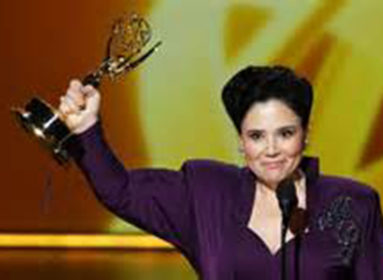
Maha Darawsha of the University of Hartford and Richard Freund present the new book on Nazareth to Ramiz Jaraisy, the mayor of Nazareth.
Israel, 2011 – I am writing this part of the history of the Greenberg Center during the final part of our summer program in Israel. Many other people and newspapers report about the political situation, strikes and scandals, but I wanted to write about some of the “untold” stories of Israel. At the moment we are finishing our work at Akko. We have carried out projects at Nazareth, Bethsaida (on the Sea of Galilee), Tel Nami (coast south of Haifa, and Yavne (north of Ashkelon)-all in one summer. Archaeology and modern Israel seem to flow together for us. Every summer our students come to Israel as a part of our academic program and get an enormous amount of exposure to Israeli culture-both modern and ancient-and a bit of tourism and social interaction. Since this is a part of our overall academic program, I wanted to write about the history of the Greenberg Center and our program in Israel and to explain how a summer, semester, or year program can change a student. Our University of Hartford students generally study Hebrew or Arabic following the excavations and submit projects that they work on all during the summer, including a journal of every experience they have in Israel during the day from the time they arrive until they go back. In general, we stay at a kibbutz during the summer and part of their experience is the kibbutz encounter-we teach students about culture, language, history, religion, and politics at lectures but also during breakfast, lunch and dinner and walks along the Sea of Galilee. We also have encounters with local Jews, Christians and Muslims in Israel that give the students an insight into the life of Israelis. We had a local photographer, Lena Stein, accompany our trip this year to prepare a photography exhibition entitled: “Veiled Women” on Jewish, Christian and Muslim women who cover their heads with a variety of different head-coverings in Israel She photographed and we did short interviews with women in Tsefat, Jerusalem, Nazareth, Beer Sheva, Druze villages, and in different churches. The exhibition that will be mounted at the University of Hartford in Spring, 2012 had to be carefully planned and it will show another part of Israeli society.
This year the Greenberg Center sponsored a sub-project in the on-going excavations at Tel Akko. We lived at Israel’s Naval Academy in downtown Akko and worked on a massive “unpublished” mound which was the ancient site of the Akko port some 3000 years ago. The site, which Israelis refer to as “Tel Bonaparte” (even though it was known until five years ago as Tel Akko) was one of the busiest ports in the Mediterranean Sea and used by the Phoenicians. If we succeed in uncovering the actual ancient port (it was sedimented in from a now defunct river which originally flowed into the Mediterranean), it might be the find of the century when we finally finish our work (stay tuned)! The Old City of Akko where the Naval Academy is located is one of the multi-cultural hubs of modern Israel. Today, Akko is 2/3 Jewish and 1/3 Arab (Muslim and Christian) and it has become a very “hip” summer place for many Israelis because of the mix of the exotic Old City and the beaches. Akko has a rich history which begins with the Phoenicians, runs through the Greeks and Romans to the Crusaders (especially the Templars of “Da Vinci Code” fame), and was the site of one of Napoleon Bonaparte’s most humiliating defeats in 1799, but also a place of infamy in the annals of the Zionist struggle before and after the Holocaust. In short, the summer program includes an education on all fronts and almost all time periods.
This summer, we had a very unique encounter in Israel that helps put in perspective why the work of the Greenberg Center is so well known. Many people might remember the Ledger’s coverage from the year 2000 when President Walter Harrison and then Chair of the University of Hartford’s Board of Regents (and founder of the Greenberg Center), Arnold Greenberg, and I met with Pope John Paul II at a formal ceremony held near our excavations of Bethsaida on the Sea of Galilee. The Pope was interested in the excavations of Bethsaida and we presented him with a replica of an artifact from the site (created by the Hartford Art School) and I had a moment to explain to the Pope the history of the artifact. The encounter made national news. This summer, I had another special encounter, this time with the Mayor of Nazareth (where the Greenberg Center is sponsoring another project). For those who do not know, Nazareth is one of the many places where the Greenberg Center has been working on excavations since 2003. On Friday, July 15, 2011, I was invited to present the Mayor of Nazareth with copies of a new book on Nazareth that was published at a publishing house in Nazareth and edited and compiled by the University of Hartford’s own professor of Arabic Language and Culture, Hazza Abu Rabia. Hazza has been teaching both Arabic language and culture and about the cities he knows best, Jerusalem and Nazareth for almost eight years. At the ceremony that I attended with my colleague, Maha Darawsha, (summer professor of Arabic and Archaeology at UHart) I started by thanking the Mayor in the name of the President of the University of Hartford and the Board of Visitors of the Greenberg Center. The copies of the book on Nazareth (written in Arabic) are to be used to educate the Arabic speaking students of Nazareth about Nazareth. The book is about not only the history of Nazareth, but about the experience of Western visitors and pilgrims who came to Nazareth over the past 1600 years. It is a remarkable book because it explains why Nazareth was important to Westerners over the past 1600 years. Hazza Abu Rabia is from Nazareth so I thanked the Mayor for accepting the books and wished him “Salam” (Peace). When someone asks me what the Greenberg Center teaches, it is simply this: The celebration of the history of ancient and modern Israel in all of its manifestations.
Modern and ancient Israel have both been central foci of our studies at the Greenberg Center over the past 25 years.
Today, we are working in Akko with students and faculty from Penn State, Haifa University, Trinity College and Claremont Graduate University. Two weeks ago at Bethsaida we were working with faculty and students from Truman State University in Missouri, two universities from Australia and New Zealand, the University of Nebraska, and two universities from England. Our UHart students have experiences that just could not take place on the University of Hartford campus. One of our students, Ben Sarnoski, a recent illustration graduate of the Hartford Art School has been illustrating the archaeological finds from Bethsaida and Akko. Each student has a project and Ben’s project is illustrating the artifacts for our academic publications.
The summer program is very intensive. Maha and I are with the students from morning until night, teaching all of the time. While the discoveries and language skills are important, we also have time to sit and talk to the students about how they are learning lessons for life. While we teach about the past, it is really a study in the present and the future that makes our program special. Maha Darawsha is a graduate of the University of Haifa in Archaeology and she finished her MA in Judaic Studies in our joint program with the University of Connecticut. During the year she teaches at UCONN and during the summer she teaches for us in Israel. Maha’s husband, Hazza Abu Rabia, teaches in Judaic Studies at UHart during the year. Hazza, like Maha, is a graduate of our Judaic Studies MA program with UCONN, and is presently undertaking his doctorate at the University of Hartford in the College of Education. When people ask me why Judaic Studies is so relevant today, I point to how our faculty and students have advanced the field.
This summer I found that some of our current and past students were in Israel almost at the same time, and many whose lives have been changed by their encounters with Israel and the Greenberg Center. In the next part of the series on the history of the Greenberg Center, I will present a short history of the faculty and some alumni over the past 25 years and how there has been a continuity of quality teaching and learning at the Greenberg Center that deserves recognition.
Shalom from Israel.








 Southern New England Jewish Ledger
Southern New England Jewish Ledger














